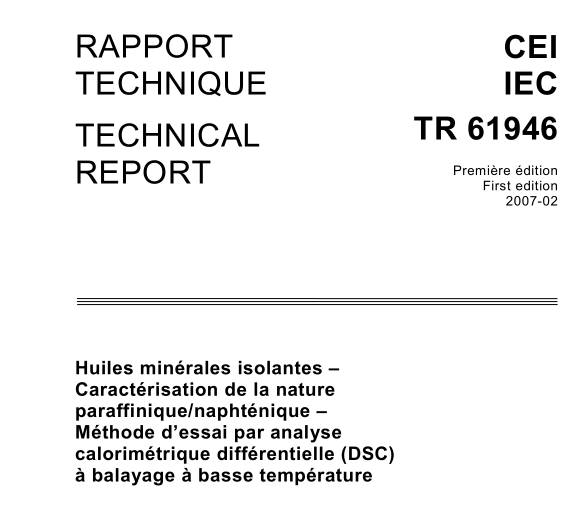IEC TR 61946:2007 pdfダウンロード

IEC TR 61946:2007 pdfダウンロード。Mineral insulating oils – Characterization of paraffinic/naphthenic nature – Low temperature differential scanning calorimetry (DSC) test method
1 Scope
This technical report offers a test method for the classification of mineral insulating oils as either paraffinic or naphthenic, by means of low-temperature differential scanning calorimetry (DSC).
For the purpose of this technical report, the typical operating temperature range extends from –1 00 °C to +1 00 °C. The temperature range can be extended, depending upon the
instrumentation used. The method is applicable to mineral insulating oils obtained from petroleum crudes. It may be also applied to mineral oils containing pour point depressants, as these additives do not prevent the formation of paraffin crystals but only the growing of such micro-crystals.
2 Normative references
The following referenced documents are indispensable for the application of this document.
For dated references, only the edition cited applies. For undated references, the latest edition of the referenced document (including any amendments) applies.
IEC 60475, Method of sampling liquid dielectrics
3 Terms and definitions
For the purposes of this document, the following terms and definitions apply.
3.1
paraffinic oil
mineral insulating oil containing crystallizable paraffins
3.2
naphthenic oil
mineral insulating oil which does not contain crystallizable paraffins
NOTE Naphthenic oils usually contain paraffins as well, but they are branched paraffins which do not form crystals at very low temperatures.
3.3
differential scanning calorimetry
DSC
technique in which the difference in energy inputs into a test material and a reference material is measured as a function of temperature while the test and the reference materials are subjected to a controlled temperature programme
NOTE In this report the terms “heat”, “heat of fusion” and “heat of crystallization” used throughout the test are taken to be equivalent to the phrases “enthalpy”, “enthalpy of fusion” and “enthalpy of crystallization”, respectively.
4 Test method
The method consists of heating (or cooling) the test specimen at a controlled rate in a controlled atmosphere through the region of melting (or crystallization). The difference in heat flow between the test specimen and the reference material due to energy changes in the material is continuously monitored and recorded as a function of temperature. A transition is marked by the absorption (or release) of energy by the test specimen resulting in a corresponding endothermic (or exothermic) peak in the heating (or cooling) curve. Integration of the energy of the recorded peak area as a function of time (or temperature) results in a measurement of the energy of the transition. Observation of the position of the transition on the temperature axis provides the necessary temperature information.
- Previous:IEC TR 61916:2009 pdfダウンロード
- Next:IEC TR 62002-3:2008 pdfダウンロード